Loquat Insect Pests
Loquat Insect Pests
Fruit fly
BiologyDevelopment from egg to adult under summer conditions requires about 16 days. The mature larva emerges from the fruit, drops to the ground, and forms a tan to dark brown puparium. Pupation occurs in the soil. About nine days are required for attainment of sexual maturity after the adult fly emerges. The developmental periods may be extended considerably by cool weather. Under optimum conditions, a female can lay more than 3,000 eggs during her lifetime, but under field conditions from 1,200 to 1,500 eggs per female is considered to be the usual production. Apparently, ripe fruit are preferred for oviposition, but immature ones may also be attacked.
- Egg - The white, elongate and elliptical egg measures about 1.17 x 0.21 mm and has a chorion without sculpturing
- Larva - The third-instar, which has a typical maggot appearance, is about 10 mm in length and creamy white. The only band of spinules encircling the body is found on the first segment. The external part of the anterior respiratory organs, the spiracles, located one on each side of the pointed or head end of the larva, has an exaggerated and deflexed lobe at each side and bears many small tubercles. The caudal segment is very smooth. The posterior spiracles are located in the dorsal third of the segment as viewed from the rear of the larva.
- Pupa - The mature larva emerges from the fruit, drops to the ground, and forms a tan to dark brown puparium about 4.9 mm in length.
- Adult - The adult, which is noticeably larger than a house fly, has a body length of about 8.0 mm; the wing is about 7.3 mm in length and is mostly hyaline. The color of the fly is very variable, but there are prominant yellow and dark brown to black markings on the thorax. Generally, the abdomen has two horizontal black stripes and a longitudinal median stripe extending from the base of the third segment to the apex of the abdomen. These markings may form a T-shaped pattern, but the pattern varies considerably. The ovipositor is very slender and sharply pointed.
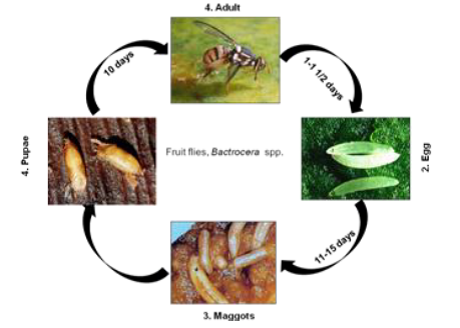
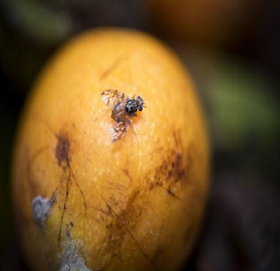
- The damage to crops caused by fruit flies result from 1) oviposition in fruit and soft tissues of vegetative parts of certain plants, 2) feeding by the larvae, and 3) decomposition of plant tissue by invading secondary microorganisms.
- Larval feeding in fruits is the most damaging. Damage usually consists of breakdown of tissues and internal rotting associated with maggot infestation, but this varies with the type of fruit attacked. Infested young fruit becomes distorted, callused and usually drop; mature attacked fruits develop a water soaked appearance. The larval tunnels provide entry points for bacteria and fungi that cause the fruit to rot. When only a few larvae develop, damage consists of an unsightly appearance and reduced marketability because of the egg laying punctures or tissue break down due to the decay.
Thrips
Biology- Egg: White, elongate and banana-shaped. Females insert eggs inside plant tissues above the soil surface. The eggs are microscopic.
- Larva: Two larval instars, pre-pupa (3rd instar), and pupa (4th instar). Mature larvae approximately 1 mm (0.04 in.) in length. Whitish larval stage with red eyes; turn yellowish in color with maturity but retain red eyes. Pre-pupa and pupa are whitish to slightly yellow. Larvae resemble adults, but wingless. The larval abdomen is up-turned and has a dot of excrement on it. The excrement can cause spotting on the leaves.
- Adult: 1.3 - 1.7 mm in length. Blackish-brown body with lighter posterior abdominal segments and white legs. Abdomen golden in newly emerged adults. Four translucent wings with numerous fringes surrounding each wing, folded back over the thorax and abdomen when at rest. Antennae have eight segments.
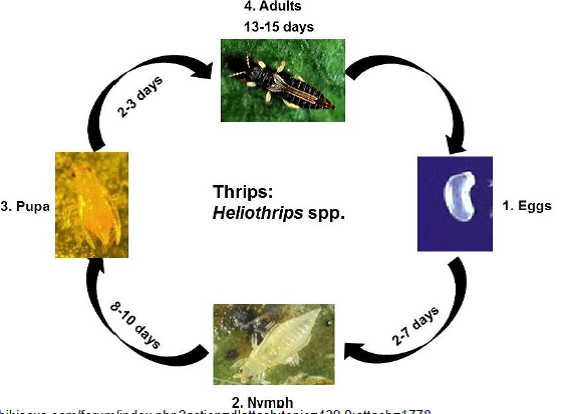
Thrips uses its mouth-parts to rasp the leaf surface, rupture the epidermal cells, and feed on exuding cell contents. Feeding spots turn yellow then brown, and the surrounds become silvery where air enters the emptied cells
Natural enemies of thrips- Parasitod: Thripobius semiluteus
- Predators: Predatory mite, predatory thrips, hover fly, mirid bug etc.
Pomegranate butterfly
Biology- Eggs: Eggs are laid singly on tender leaves, stalks and flower buds.
- Larvae - Dark brown, short and stout, covered with short hairs, larval period lasts for 18-47 days.
- Pupa: Development occurs either inside the damaged fruits or on the stalk holding it. Pupal period lasts for 7-34 days. Total life cycle is completed in 1 to 2 months.
- Adult - bluish brown butterfly, Female – V shaped patch on forewing
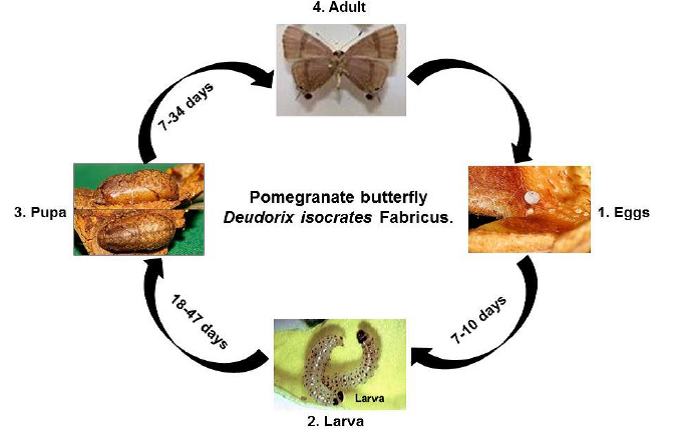
- Caterpillar/larva bores into young fruits.
- Feeds on internal contents (pulp and seeds) making the fruit hollow from inside.
- Fruit rotting and dropping.
- Parasitoids: Trichogramma chilonis, Tetrastichus spp., Telenomus spp., Chelonus blackburni, Carcelia spp. Campoletis chlorideae, Bracon spp.
- Predators: Chrysoperla, Rove beetles, Spiders, Coccinellids, Robber fly, Dragonfly, Reduviid bug, Praying mantis, Fire ants, Big eyed bugs, Pentatomid bug, Earwigs, Ground beetles, common mynah and King crow
Bark eating caterpillar
Biology- Eggs: Eggs are laid under loose bark or in cracks and crevices in clusters of 15-25 from April to June. Eggs hatch in 8-11 days. Eggs are oval in shape and reddish in colour.
- Larva: Caterpillars are pinkish white with brown spots and are about 40mm long. Larval duration is of 8-10 months.
- Pupa: Pupae are chestnut-brown in colour and 22 to 28 mm long, Pupal period is 21- 41 33 days. Total life cycle lasts 4-5 months in south India and more than a year in north India. One generation per year.
- Adult: Moths are white with pairs of small black dots on thorax, numerous small black spots and streaks on fore wings and few black spots on posterior edges of hind wings.
Life cycle
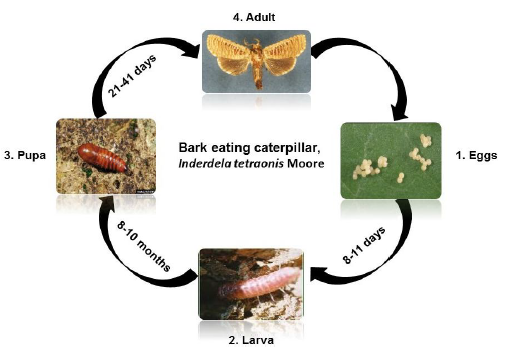
Damage symptoms
- The infestation of the pest may be identified by the presence of irregular tunnels and patches
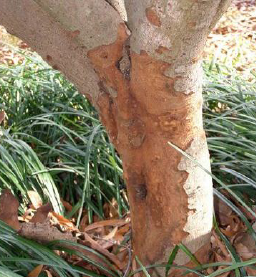 covered with silken web consisting of excreta and chewed up wood particles on the shoots, branches, stem and main trunk.
covered with silken web consisting of excreta and chewed up wood particles on the shoots, branches, stem and main trunk. - Holes on the trunk, Wood dust and faecal matter hanging in the form of a web around the affected portion.
- Severe damage can result in the death of attacked stem. Blackish larva can be observed underneath the fresh webbing.
- Shelter holes may also be seen particularly at the joints of shoots and branches.
- The young shoots dry and die away giving sickly look to the plant.
Aphid
BiologyThe development of this aphid is temperature dependent. At 25˚C a generation (nymph to adult) may take as little as 6 days. In cooler temperatures (below 15˚C), a generation may take as long as 20 days. Higher temperatures also reduce development rate, at 30˚C populations of this aphid will sharply decline. Generations are continuous throughout the year in Hawaii.
- Egg: Eggs are not produced by this species. Females give birth to living young.
- Nymph: There are four nymphal stages of this aphid. The first stage is approximately 1/36 inch in length and the last about 1/17 inch. They are without wings and brownish in color.
- Adult: Only females are found. They are oval, shiny black, brownish-black or reddish brown in color, either with or without wings, measuring 1/25 to 1/12 inch in body length and having short black-andwhite banded antennae. Winged individuals tend to have darker abdomens and be slightly thinner. The incidence of winged individuals is dependent on the population density and leaf age. Reproduction is partheneogenic or non sexual. Females start reproducing soon after becoming adults. They produce 5 to 7 live young per day, up to a total of about 50 young per female.
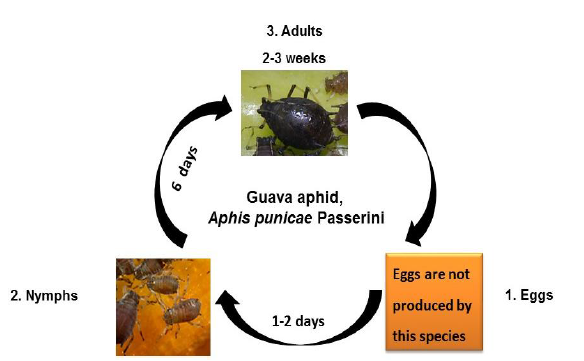
- Aphid sucks sap and weakens attacked tissue.
- In the spring, it is very harmful to fruits, causing flower buds to drop off. The abundant honeydew it produces attracts ants and allows the development of sooty moulds.
- Parasitods: Aphidius colemani, Praon volucre, Lysiphlebus fabarum, Lysiphlebus testaceipes, Diaeretiella rapae
- Predators: Allobaccha nubilipennis, Episyrphus balteatus, Chrysoperla carnea, Coccinella septempunctata, Betasyrphus serarius, Paragus tibialis, Ischiodon scutellaris, Dideopsis aegrota
Grey weevil
Biology- Egg: Small, ovid and cream colored
- Grub: C shaped, creamy white with brown heads and legeless
- Pupa: Creamy white and resemble adults, and are found in earthern cells in the soil
- Adult: Whitish grey with an irregular pattern of dark spots dorsally. The snout is short and quadrate and slightly expanded towards the apex. The antennae are clubbed and elbowed
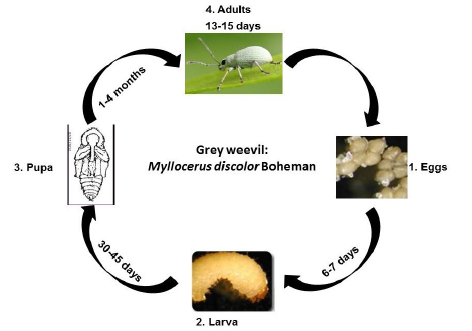
Adults feed on leaf edge and cutting U shaped pattern and thus defoliate the plants, grubs feeds on the roots.
Scale
Biology- Larva: Flat, oval, yellowish green, moving slowly.
- Adult: Only females known. Immobile, usually settled at underside of leaf, close to central vein or near tips of green shoots. Flat, oval (about 3 x 2 mm), green with irregular loop of blackish spots showing through middle of dorsum.
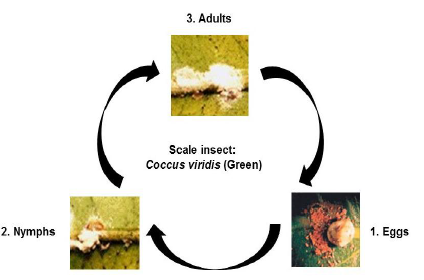
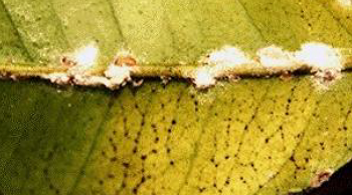
- Parasitods: Anicetus annulatus, Cerapteroceroides similis, Coccophagus cowperi, Marietta leopardina, Encyrtus lecaniorum
- Predators: Chilocorus cacti, Chilocorus melanophthalmus, Chilocorus nigrita, Cryptolaemus montrouzieri and Jauravia pallidula
Chafer beetle
Biology- Eggs: About 50 eggs laid by a single female in soil at 5-10 cm depth. Eggs hatch in 8-10 days
- Larva: Full gown larvae are C shaped. The larvae remains in the soil and eat the roots. Larval period is 60-70 days
- Pupa: Pupation takes place in the soil at 20-30 cm depth. Pupal period is 12- 16 days.
- Adult: Adult beetle emerge with onset of rains during May – June. They are active at night and mate. They hide during daytime. Life cycle is completed in about 90 days.
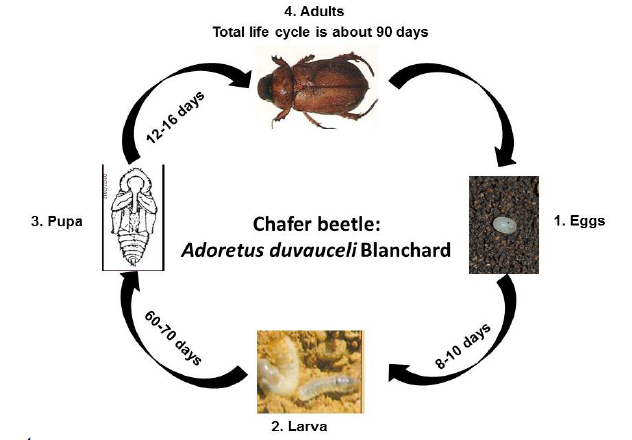
- Both adults and larvae are destructive. Adult beetle start feeding from the periphery of leaves and tender shoots at night.
- The larvae cut the roots in certain cases, the damage is serious.
Root-knot Nematode
Biology- Most species of plant parasitic nematodes have a relatively simple life cycle consisting of the egg, four larval stages and the adult male and female.
- Development of the first stage larvae occurs within the egg where the first molt occurs. Second stage larvae hatch from eggs to find and infect plant roots or in some cases foliar tissues.
- Under suitable environmental conditions, the eggs hatch and new larvae emerge to complete the life cycle within 4 to 8 weeks depending on temperature.
- Nematode development is generally most rapid within an optimal soil temperature range of 70 to 80°F.
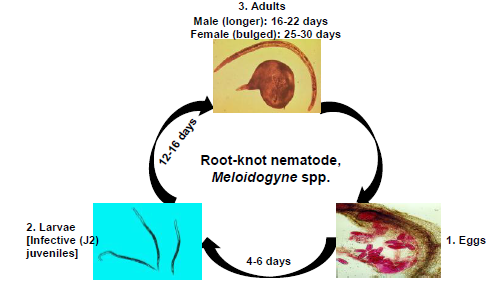
- Formation of galls on host root system is the primary symptom
- Roots branch profusely starting from the gall tissue causing a ‘beard root’ symptom
- Infected roots become knobby and knotty
- In severely infected plants the root system is reduced and the rootlets are almost completely absent. The roots are seriously hampered in their function of uptake and transport of water and nutrients
- Plants wilt during the hot part of day, especially under dry conditions and are often stunted
- Nematode infection predisposes plants to fungal and bacterial root pathogens
- Primary : Egg masses in infected plant debris and soil or collateral and other hosts like Solonaceous, Malvaceous and Leguminaceous plants act as sources of inoculums.
- Secondary: Autonomous second stage juveniles that may also be water dispersed.
Favourable conditions : Loamy light soils
IPM for Loquat
To know the IPM practices for Loquat, click here.
Source : NIPHM; Directorate of Plant Protection, Quarantine & Storage
Last Modified : 4/1/2020
This topic covers the information related to insec...
This topic covers the information related to insec...
This topic covers the information related to Insec...
This topic covers information about Ber Insect and...
